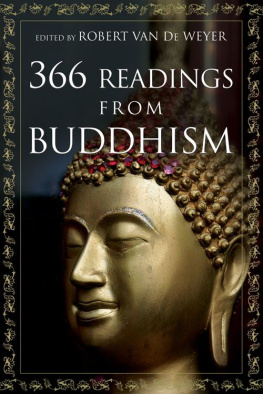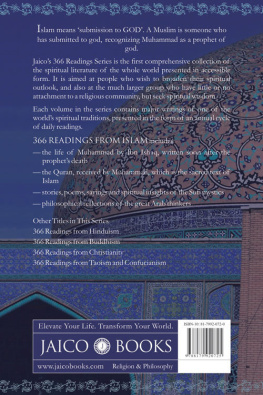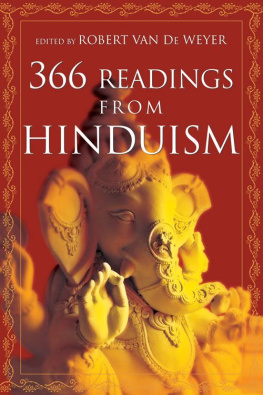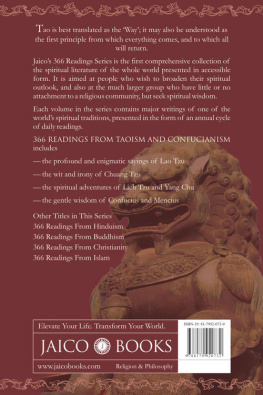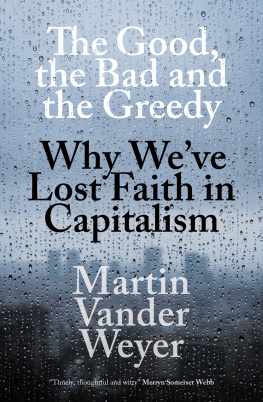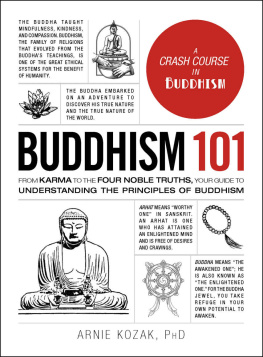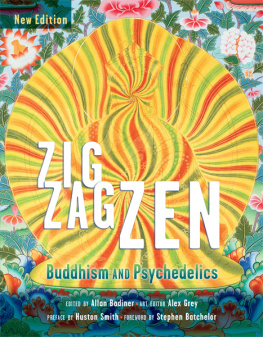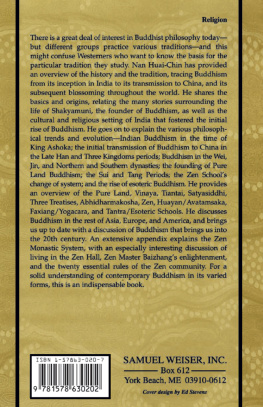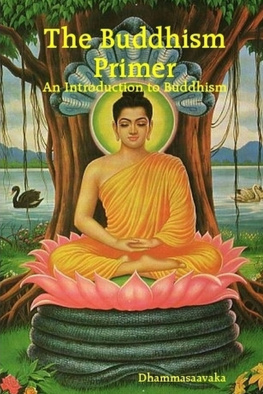Robert Van De Weyer - 366 Readings From Buddhism
Here you can read online Robert Van De Weyer - 366 Readings From Buddhism full text of the book (entire story) in english for free. Download pdf and epub, get meaning, cover and reviews about this ebook. year: 2013, publisher: Laurier Books, genre: Religion. Description of the work, (preface) as well as reviews are available. Best literature library LitArk.com created for fans of good reading and offers a wide selection of genres:
Romance novel
Science fiction
Adventure
Detective
Science
History
Home and family
Prose
Art
Politics
Computer
Non-fiction
Religion
Business
Children
Humor
Choose a favorite category and find really read worthwhile books. Enjoy immersion in the world of imagination, feel the emotions of the characters or learn something new for yourself, make an fascinating discovery.
- Book:366 Readings From Buddhism
- Author:
- Publisher:Laurier Books
- Genre:
- Year:2013
- Rating:4 / 5
- Favourites:Add to favourites
- Your mark:
- 80
- 1
- 2
- 3
- 4
- 5
366 Readings From Buddhism: summary, description and annotation
We offer to read an annotation, description, summary or preface (depends on what the author of the book "366 Readings From Buddhism" wrote himself). If you haven't found the necessary information about the book — write in the comments, we will try to find it.
366 Readings From Buddhism — read online for free the complete book (whole text) full work
Below is the text of the book, divided by pages. System saving the place of the last page read, allows you to conveniently read the book "366 Readings From Buddhism" online for free, without having to search again every time where you left off. Put a bookmark, and you can go to the page where you finished reading at any time.
Font size:
Interval:
Bookmark:
READINGS
FROM
BUDDHISM
EDITED BY
ROBERT VAN DE WEYER

JAICO PUBLISHING HOUSE
Ahmedabad Bangalore Bhopal Bhubaneswar Chennai
Delhi Hyderabad Kolkata Lucknow Mumbai
Published by Jaico Publishing House
A-2 Jash Chambers, 7-A Sir Phirozshah Mehta Road
Fort, Mumbai - 400 001
www.jaicobooks.com
Arthur James Ltd.
Translation, Compilation and Editing
Robert Van de Weyer
Published in arrangement with
John Hunt Publishing Ltd.
46a West Street, New Alresford
Hants SO24 9AU, UK.
366 READINGS FROM BUDDHISM
ISBN 81-7992-071-2
First Jaico Impression: 2003
Eleventh Jaico Impression: 2012
No part of this book may be reproduced or utilized in
any form or by any means, electronic or
mechanical including photocopying, recording or
by any information storage and retrieval system,
without permission in writing from the publishers.
CONTENTS
Also in the Global Spirit Library
366 readings from Islam
366 readings from Christianity
366 readings from Taoism and Confucianism
366 readings from Hinduism
SERIES INTRODUCTION
The Global Spirit Library is the first comprehensive collection of the spiritual literature of the world, presented in accessible form. It is aimed at people who belong to a particular religious community, and wish to broaden their spiritual outlook; and at the much larger group, perhaps the majority of people in the world today, who have little or no attachment to a religious community, but seek spiritual wisdom. Each book contains the major writings of one of the worlds spiritual traditions.
Much of the world's spiritual literature was designed to be read or heard in small portions, allowing ample time for personal reflection. Following this custom, the books in The Global Spirit Library each consist of an annual cycle of daily readings. Two or more books may be read in parallel at different times of the day; or an entire book may be read straight through. Again following a time-honoured practice, many of the original texts have been condensed.
Spiritual traditions differ from one another in their theological formulations; and the history of humankind is blighted by rivalry between different religious communities. Yet theology is no more than human speculation about truths that are beyond the grasp of the human mind. The writings in these books amply demonstrate that, as men and women actually experience these truths within themselves and others, divisions and rivalries fade, and unity is found. May the third millennium be an era of spiritual unity across the globe.
INTRODUCTION
Buddha means enlightened person. A Buddhist is someone who follows the teachings of a particular enlightened person, called Gautama.
In approximately the year 534 BCE , in northern India, Gautama attained enlightenment, while sitting cross-legged under a tree. He then devoted the rest of his life to teaching others the spiritual wisdom he had acquired. He established a large Community of monks and nuns, and also had numerous lay disciples. Although commonly referred to as the Buddha, he saw himself as one of countless enlightened teachers, who appear in every age and in every society. In the centuries after his death Buddhism spread thoughout southern and eastern Asia.
THE TEACHINGS OF THE BUDDHA
Soon after the Buddha had died, the monks of his Community began the task of recording his teachings. These records were made in Pali, a literary variant of the language which the Buddha himself spoke. The Pali Canon, as the records are known, is immensely long, running into many volumes, and is highly repetitive, with similar passages often appearing in several places. Yet certain parts manifestly contain the essence of his teachings; while other parts have come to be regarded as developing his teachings with special beauty and clarity.
The Pali Canon is not in any way a biography of the Buddha; and the Buddha discouraged any attention to his own particular circumstances and personality. The place where a sermon was delivered, is usually given, as are the names of people he encountered. Thus we know that his ministry was largely confined to the kingdoms of Magadha in northern India, and Kossala, which corresponds roughly with modern Nepal; and he mixed freely with people of all social classes. Nonetheless the Pali Canon contains a vivid account of the period immediately after his enlightenment; and in one sermon he gives a glimpse of his early life. Later biographies, which suggest that he grew up as a prince, are speculative.
The origin of suffering
The Buddha attained enlightenment sitting under a tree on the bank of the river Nerengara at Uruvela. He remained there, sitting cross-legged, for seven days without interruption, enjoying the bliss of salvation.
Then during the first part of the night he meditated on the chain of causation:
From ignorance spring body, speech and mind.
From body, speech and mind springs consciousness.
From consciousness spring the names and forms of objects.
From the names and forms spring the six senses of seeing, hearing, smelling, tasting, touching and thinking.
From the six senses springs contact with objects.
From contact springs sensation.
From sensation springs desire.
From desire springs attachment.
From attachment springs birth.
From birth spring old age, death, grief, pain and despair.
In this manner the whole mass of suffering in the world originates.
Mahavagga 1:1.12
The destruction of suffering
The Buddha continued to meditate on the chain of causation.
By the destruction of ignorance, body, speech and mind are destroyed.
By the destruction of body, speech and mind, consciousness is destroyed.
By the destruction of consciousness, the names and forms of objects are destroyed.
By the destruction of the names and forms of objects, the six senses are destroyed.
By the destruction of the six senses, contact is destroyed.
By the destruction of contact, sensation is destroyed.
By the destruction of sensation, desire is destroyed.
By the destruction of desire, attachment is destroyed.
By the destruction of attachment, birth is destroyed.
By the destruction of birth, old age, death, grief, pain and despair are destroyed.
In this manner the whole mass of suffering in the world may cease.
When the Buddha had finished meditating on the chain of causation, his uncertainties faded, and he understood the nature of all things.
Mahavagga 1:1.23
The first lay disciples
At the end of seven days the Buddha emerged from a state of meditation, rose up, and went to a banyan tree. He sat cross-legged for a further seven days without interruption, enjoying the bliss of salvation.
A priest, with an arrogant disposition, came and sat near the Buddha. Then he asked the Buddha: 'What are the characteristics of true priests?' The Buddha replied: 'True priests are those who have abandoned all sins, who are free from arrogance, who are pure and self-controlled, who are wise and learned, who have achieved a high degree of holiness, and whose behaviour does no harm to any living being.'
At the end of seven days the Buddha emerged from a state of meditation, rose up, and went to tree known as Ragayatana. He sat cross-legged for a further seven days without interruption, enjoying the bliss of salvation.
Two merchants, Tapussa and Bhallika, passed by. They felt prompted to pay homage to the Buddha, offering him rice- cakes and honey. The Buddha wondered whether it was ap-propriate for him, having attained enlightenment, to accept their gift. But after a while he felt prompted to do so; and he ate the rice-cakes and the honey. Then Tapussa and Bhallika said: 'We put our trust in you, enlightened one, and in the Way which you have followed. We ask you to accept us as your disciples, from today until the end of our lives.' Thus these two merchants were the first lay disciples of the Buddha.
Next pageFont size:
Interval:
Bookmark:
Similar books «366 Readings From Buddhism»
Look at similar books to 366 Readings From Buddhism. We have selected literature similar in name and meaning in the hope of providing readers with more options to find new, interesting, not yet read works.
Discussion, reviews of the book 366 Readings From Buddhism and just readers' own opinions. Leave your comments, write what you think about the work, its meaning or the main characters. Specify what exactly you liked and what you didn't like, and why you think so.

